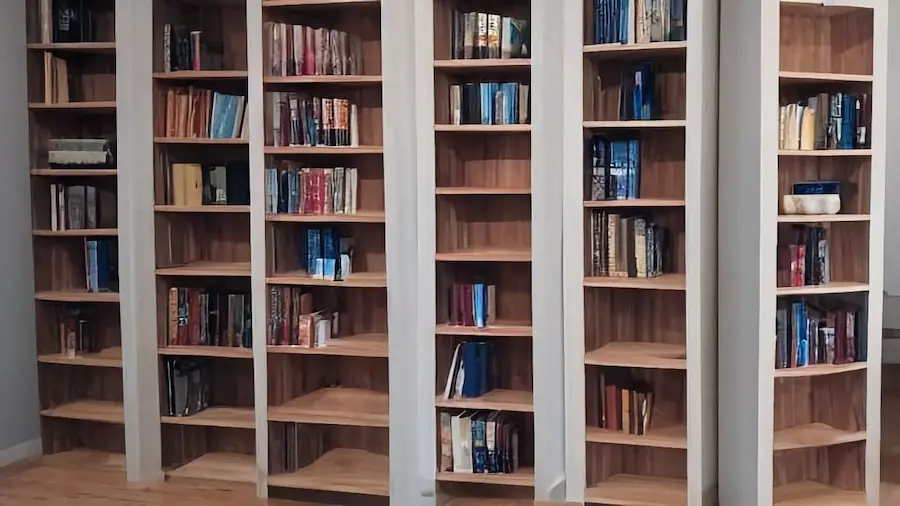~ 5 min read
The Best Wood for Bookshelves: How to Choose the Right Material for Your Bookcase

Bookshelves come in thousands of different styles, shapes, and materials. While you can find wood bookshelves in various wood types, wood remains the most common material used to make bookshelves.
While wood is a beautiful and highly durable material, it’s not the right choice for every bookshelf situation. In some cases, wood is joined with other materials to create a more durable and long-lasting bookshelf. For example, wood is often joined with metal to create a wood-metal bookshelf, which combines the best of both materials.
Different types of wood for bookshelves
When choosing wood for your bookshelves, it is essential to know the durability and the appearance of various wood types. While wood may be the most popular material for bookshelves, it may not be the best choice for your situation. The type of wood you choose for your bookshelves will depend on your design, the durability you need, and the kind of wood that is available in your area.
Pine
Pine is often used for furniture such as common wood because it’s easy to work with. It has a smooth, clean grain that allows for a smooth finish. Pine is naturally lightweight and aromatic, making it popular for bookshelves.
Oak
Solid wood options are excellent for bookshelves because they don’t require finishing. These types of wood, such as oak, have a smooth grain structure and are less likely to experience warping or shrinkage over time.
Maple
Maple is a natural wood that’s stronger than typical hardwood. As a result, it lasts longer and is less prone to warping and cracking. Real wood is often more expensive than fake wood, but it’s worth the extra money.
Cherry
Woods that are excellent for storage spaces because they resist moisture and insects while still looking great include cherry wood. This popular trim and cabinetry wood is also suitable for bookshelves because it holds nails and screws well.
Walnut
Depending on your preference, different types of wood can be used to build bookshelves. For example, walnut is a stronger wood than pine, but some people find the lighter color and smooth finish of pine more attractive. Hardwoods such as walnut and oak are popular choices because they’re easier to maintain and can withstand scratches and scuffs better than softer woods such as pine.
Using Plywood for Bookshelves
Composite wood is an excellent choice if you don’t want to use solid wood. Plywood is a good material, but a composite wood product with a strong core of medium-density fiberboard (MDF) is an excellent choice. This is because you will bear the weight of books and the shelving unit on the core, not the plies.
There are other composite wood products on the market with a core of chipboard, which is a shallow grade of MDF but made from waste wood products and is much less expensive than MDF. You will bear the weight of the shelving unit on the chipboard, which will soon warp, crack, and split.
The core of a composite wood shelving unit should be made from MDF, a wood product that is powerful, sturdy, and highly durable. Even the best composite wood products will warp, crack, and split over time, but the MDF core will hold well.
Pros and Cons of Plywood
Plywood is an affordable option for bookcases that We can make into solid wood pieces by laminating multiple sheets of plywood into boards. The plywood can be purchased in sheets the same size as standard lumber pieces or in a thinner grade that You can cut down to the extent you need.
Plywood is one of the most common materials for bookcase construction, but it does have some drawbacks. Because plywood is pressed wood, it does not have the same grain pattern as solid wood. This can make the surface feel a little less smooth and less appealing.
The biggest drawback to using plywood for bookshelves is that it can be more susceptible to warping and bowing than solid wood pieces. You can try to correct this issue by adding braces between the shelves, making the bookcase more challenging to construct.
Many types of wood can be used for bookshelves, but some are better than others. Hardwoods such as oak and maple are good choices, as they are solid and durable. Softer woods like pine may be less expensive, but they are not as sturdy and can be damaged more easily.
When choosing the best wood for your bookshelves, consider the type of wood, the weight of the books you will be storing, and the overall look you want. With a bit of research, you can find the perfect material to help you create the ideal bookcase for your home.
Related Reading: